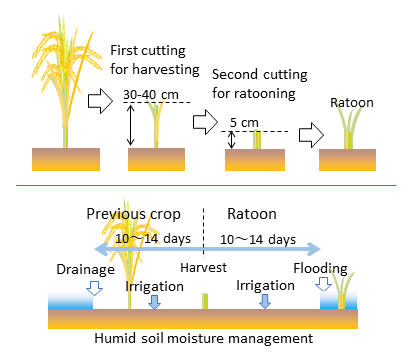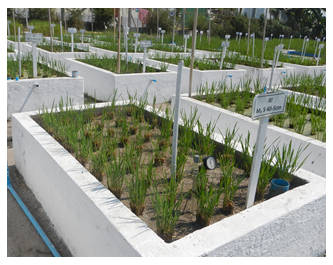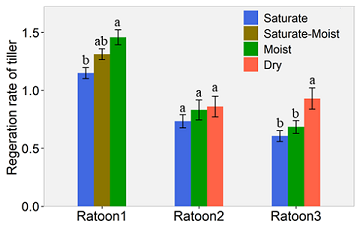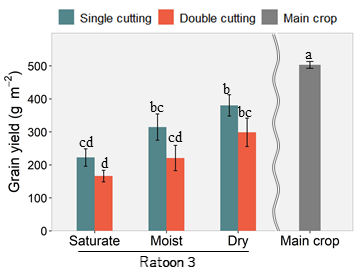Soil oxidation conditions during the initial growth period of ratoons could contribute to improve the yield performance of ratoons
Description
Compared with conventional double-season rice cropping, ratoon rice cropping can reduce production cost because of its advantages in labor, seed, seedbed and water savings. However, the grain yield of ratoon rice is only 40%–60% that of the main crop; thus, most of ratoon cropping is only practiced by farmers as an afterthought. In recent years, in West Sumatra, Indonesia, a perennial rice cropping system called SALIBU has been practiced and found to produce a yield equivalent to that of single rice cropping multiple times annually. Therefore, this study focused on the SALIBU method, whose unique features are double-cutting of stem and humid soil moisture management during the harvesting stage (Fig. 1), in order to find the factors that increase the yield of ratoon. We conducted cultivation trials using a concrete tank (Fig. 2) in Naypyidaw, Myanmar, to evaluate the effect of the cutting times and the soil moisture regimes on grain yield and regeneration rate of ratoon in tropical regions.Experiments were conducted using a concrete tank filled with paddy to evaluate cutting regimes (single- and double-cutting) and soil moisture regimes (saturated, moist and dry). Double cropping (main crop + 1st ratoon) was carried out from February to August 2019 (first trial), and triple cropping (main crop + 2nd ratoon + 3rd ratoon) was implemented from September 2019 to May 2020 (second trial). Summarizing for the moisture regimes, the soil water potentials of the saturated, saturated-moist, moist, and dry regimes were approximately 0 kPa, –5 kPa, –11 kPa, and –19 kPa, respectively, and the soil redox potentials of the saturated, saturated-moist, moist and dry were 200 mV, 100 mV, 200 mV, and 550 mV, respectively. There were significant differences between moisture regimes with regard to grain yield and regeneration rate of tiller (Fig. 3 and Fig. 4). Double cutting (a cutting height of 30–40 cm for harvesting and a height of 5 cm for ratooning) had no positive effect on grain yield and regeneration rate compared with single cutting. If there is no increase in yield commensurate with the cost of the additional cutting, stem cutting of ratoon should be cut once with a height of 5 cm at the time of harvesting. The dried soil moisture conditions promote the increase of easily-decomposable nitrogen compounds and the supply of inorganic nitrogen, and activates root respiration. Hence, improving the rhizosphere environment in the initial growth stage of ratoon in soil under oxidation conditions will contribute toward increasing the yield of ratoon.
The above scenario is the result of using a concrete tank that allows for easy drainage management, and various drainage measures such as designing the drainage channel must be considered to improve the yield of ratoon in paddy fields. Water management (amount, frequency, and period of irrigation) during the harvesting stage of the previous crop should be carried out while considering the air temperature, rainfall, water retention of paddy soil, and plant growth of ratoon.
Figure, table
-
Fig. 1. Double cutting of stem and soil moisture management during the harvesting stages of the previous crop, which are unique features of Indonesia’s perennial rice cropping system (SALIBU)
-
Fig. 2. Cultivation trial using concrete tanks (L 1.8 m × W 0.9 m × D 0.4 m) in a split-plot design, comprising a total of 24 plots (2 cutting, 3 moisture and 4 replications)
-
Fig. 3. Effect of soil moisture regime on the regeneration rate of ratoon crops at 3 weeks after harvesting
Ratoon crops were harvested by the single cutting of stem. Regeneration rate of tiller was defined as the ratio calculated by the tiller of ratoon divided by that of residual stubble. Error bars indicate the standard errors (n = 16). Same letters above the bar indicate that there is no significant difference at the 5% level by Tukey’s HSD test.
-
Fig. 4. Effect of cutting times and soil moisture regimes on the grain yield of ratoon, shown by comparing the 3rd ratoon with the main crop
The error bars indicate the standard errors (n = 4). Same letters above the bar indicate that there is no significant difference at the 5% level by Tukey’s HSD test.
- Affiliation
-
Japan International Research Center for Agricultural Sciences Rural Development Division
- Classification
-
Research
- Research project
- Program name
- Term of research
-
FY2020(FY2016~FY2020)
- Responsible researcher
-
Shiraki Shutaro ( Rural Development Division )
Yamaoka Kazumi ( Research Planning and Partnership Division )
Thin Mar Cho ( Department of Agricultural Research, Myanmar )
Khin Mar Htay ( Department of Agricultural Research, Myanmar )
- ほか
- Publication, etc.
-
https://doi.org/10.3390/agronomy10111621
Shiraki S et al. (2020) Agronomy, 10:1621
- Japanese PDF
-
2020_A04_A4_ja.pdf600.25 KB
2020_A04_A3_ja.pdf511.69 KB
- English PDF
-
2020_A04_A4_en.pdf486.76 KB
2020_A04_A3_en.pdf399.54 KB
- Poster PDF
-
2020_A04_poster.pdf302.11 KB
* Affiliation at the time of implementation of the study.




